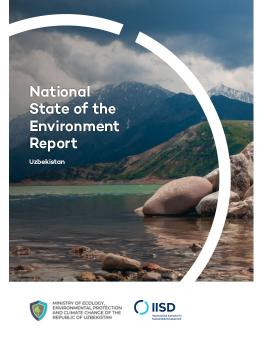
National State of the Environment Report: Uzbekistan
A healthy environment and its sustainable management are critical for citizens' well-being and supporting Uzbekistan's growing economy. The National State of the Environment Report (NSoER) is a comprehensive document that provides a snapshot of current environmental trends in Uzbekistan's socio-economic development for citizens, experts, and policy-makers. This report was prepared with the support of the United Nations Economic Commission for Europe, the United Nations Environment Programme (UNEP), and the Food and Agriculture Organization of the United Nations, along with financial support from the Global Public Goods and Challenges Programme Cooperation Agreement between the European Commission and UNEP.
-
A decade of environmental change is captured in the recent National State of the Environment Report of Uzbekistan.
-
The National State of the Environment Report is a comprehensive document that provides a snapshot of current environmental trends in Uzbekistan's socio-economic development for citizens, experts, and policy-makers.
-
Decade of trends for critical environmental issues, including air, water, and biodiversity, are reviewed in the recent National State of the Environment Report.
The analyzed environmental trends need to inform decision making and improve citizen engagement in natural resource management and environmental protection. This report thus aims to connect actions creating drivers and pressures influencing the state of the environment and relevant responses to address environmental challenges.
Our approach uses the Drivers– Pressures–State–Impacts–Responses (DPSIR) framework to draw connections between the state of the environment and the drivers and pressures on the environment. The framework brings together five critical elements of development in a connected framework to integrate the causes of environmental degradation (as well as environmental improvements) into a chain of causes and consequences. The DPSIR framework provides a suitable model for describing the interaction between human activities and the environment.
Based on the application of the DPSIR framework, the NSoER team, with the participation of stakeholders, identified the specific drivers, pressures, and components of the environment, such as atmospheric air, water resources, land, and specific ecosystems.
Participating experts
You might also be interested in
IISD Annual Report 2023–2024
While IISD's reputation as a convenor, a trusted thought leader, and a go-to source on key issues within the sustainable development field is stronger than ever, the work happening outside the spotlight is just as valuable.
IGF Case Study: Decarbonization of the Mining Sector
Case studies from Chile, Indonesia, and South Africa that delve into the role of the mining sector in efforts to reduce greenhouse gas (GHG) emissions.
Unlocking Supply Chains for Localizing Electric Vehicle Battery Production in India
This study aims to highlight the key supply chain barriers in localizing electric vehicle (EV) battery cell manufacturing in India. It summarizes consultations with 12 companies, as well as experts and policy-makers, to determine the crucial challenges and opportunities in localizing battery manufacturing in India.
What Will Happen at COP 29?
Talks at the 2024 UN Climate Change Conference (COP 29) will range from defining a way forward on finance through a new collective quantified goal (NCQG) to mitigation, and loss and damage. Ahead of negotiations in Baku, IISD’s Earth Negotiations Bulletin Team Lead Jennifer Bansard examines the agenda and breaks down what to watch as eyes turn to Azerbaijan.